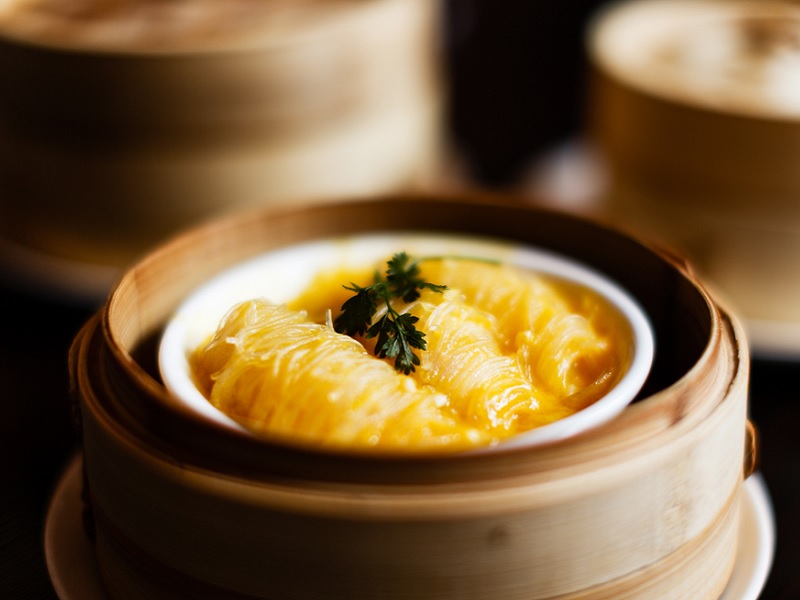Chefs Liang Koon Chuen & Stephen Chan of Park Chinois, London
by Qian Leung
@ 05 Jan 2018

In the 1880s, Chinese seamen who brought tea, ceramics, and silks settled in London, giving rise to a Chinatown. By the 1950s, a hundred Chinese restaurants were open, a growing industry which provided work for a wave of agricultural labourers from Hong Kong. Today, the Chinese community is largely made up of second or third generation British Chinese. What is Chinese food like in London? Let’s hear the thoughts of two chefs.

Chef Stephen Chan & Chef Liang Koon Chuen
Within a bamboo basket, morsels of ethereal white, yellow, orange, jade green, and black twinkle with touches of gold and black truffle. Upon closer look, what seem to be technicoloured precious stones are in fact bites of dim sum, such as har gau (shrimp dumpling), shumai (pork and mushroom dumpling), and Shanghai siew long dumpling (soup-filled bun). “Compared to the western kitchen, the Chinese kitchen is more complicated,” acknowledges Chef Liang Koon Chuen of
Park Chinois. “The menu is thicker, the recipes are more elaborate.” A grilled XO black cod, with asparagus and soy sauce, is sweet, juicy, and fork tender, while the Peking duck, served with pancakes, leek, and duck sauce, has its skin roasted to such perfection that it crackles under your palate, leaving a faintly smoky and aromatic scent from the glistening coat of its own oils.

“A lot of people have the impression that working in a Chinese kitchen is tiring; your uniform is always oily and smoky, and you don’t get any holidays,” the 40-year-old Malaysian chef, formerly from Hakkasan Mayfair, laughs. “But to me, there is so much learning, testing, and tasting that need to pass my own standards, before I can even send a plate out of the confines of my kitchen.” Uppermost in his consciousness, always, is the knowledge that each bite will go on to satisfy the hunger of a fellow human being, sustaining them and nourishing them. If you get the chance, be sure to order the French spiney lobster, served over vermicelli noodles smothered in a rich, creamy, and flavoursome gravy.

“Rather than the appearance of the dish, I would say that the taste matters more to us,” says Chef Stephen Chan, executive sous chef, who was born in London to Cantonese immigrants. “Ingredients are so important. We have such a close relationship with our suppliers, they sometimes whatsapp us at four in the morning to ask if we want, say, a huge tail of fish that they’ve just caught.” In the evenings, vintage songs and an open dance floor sweeps you back into the opulence and decadence of 1930s Shanghai. The Opera, set behind the band, offers a front row experience, while Salon Rouge, a pocket set behind the stage, even has its own private entrance. In the midst of the French Chinoiserie, the two Chinese chefs turn contemplative when the conversation turns to the future of their craft. “I hope to see new blood in the Chinese kitchen, if not, many heritage cooking techniques will be lost,” says Chef Liang. Chef Chan adds, “Cooking is a social skill, and it’d be wonderful if young people would find time to cook a meal with their mom.”

Adapted from the Jan Feb 18 issue of Cuisine & Wine Asia.
 In the 1880s, Chinese seamen who brought tea, ceramics, and silks settled in London, giving rise to a Chinatown. By the 1950s, a hundred Chinese restaurants were open, a growing industry which provided work for a wave of agricultural labourers from Hong Kong. Today, the Chinese community is largely made up of second or third generation British Chinese. What is Chinese food like in London? Let’s hear the thoughts of two chefs.
In the 1880s, Chinese seamen who brought tea, ceramics, and silks settled in London, giving rise to a Chinatown. By the 1950s, a hundred Chinese restaurants were open, a growing industry which provided work for a wave of agricultural labourers from Hong Kong. Today, the Chinese community is largely made up of second or third generation British Chinese. What is Chinese food like in London? Let’s hear the thoughts of two chefs.


